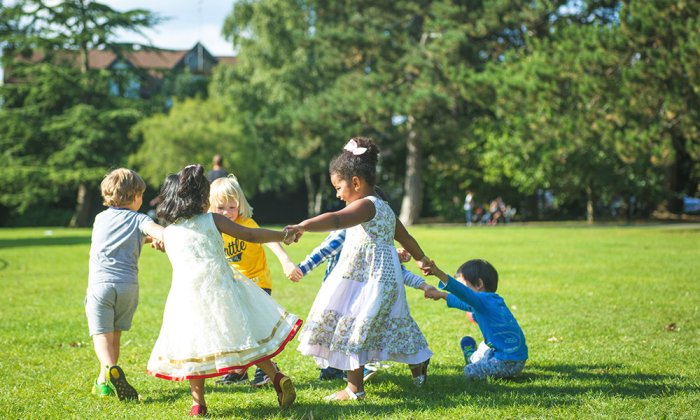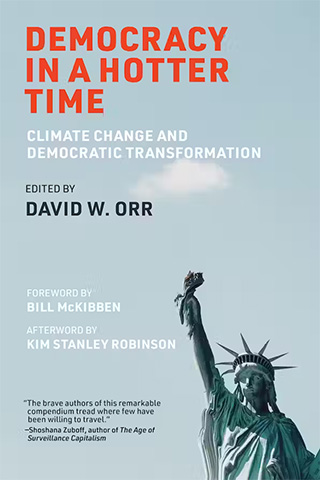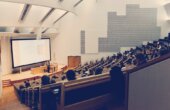Greening Democracy: The Transformative Power of Nature on Children and Society

At first glance, the topics of nature, children, and democracy may not seem related. But they are. To explain this relationship, let me start with a story I’ve told often in recent years.
More than two decades ago, I visited Southwood Elementary, the grade school I attended when I was a boy growing up in Raytown, Missouri. From the windows of the classroom, I could see the same trees, branches bare, that I had watched dip and sway when I was a boy.

In that classroom, I asked fifth graders about their relationship with nature. Many of them offered the now-typical response. On those occasions when they were outside, the students were more likely to be playing soccer or some other adult-organized sport. More than a few said they preferred playing indoors, because, as a third grader in another school once told me, “That’s where all the electrical outlets are.”
Then an 11-year-old stood up. She was wearing a plain print dress and an intensely serious expression. Earlier, a teacher had described her as “our little poet.”
“When I’m in the woods,” the little poet said, “I feel like I’m in my mother’s shoes.”
To her, nature represented beauty, refuge, and healing. “It’s so peaceful out there and the air smells so good. For me, it’s completely different there. It’s your own time. Sometimes I go there when I’m mad — and then, just with the peacefulness, I’m better. I can come back home happy, and my mom doesn’t even know why.”
She paused, then said, “I had a place. There was a big waterfall and a creek on one side of it. I’d dug a big hole there, and sometimes I’d take a tent back there, or a blanket, and just lay down in the hole, and look up at the trees and sky. Sometimes I’d fall asleep back in there. I just felt free; it was like my place, and I could do what I wanted, with nobody to stop me. I used to go down there almost every day.”
The young poet’s face flushed. Her voice thickened. “And then they just cut the woods down. It was like they cut down part of me.”
If the eminent biologist E. O. Wilson’s “biophilia hypothesis” is correct — that the human attraction to the rest of nature is genetically hardwired within us — then our young poet’s heartfelt statement was more than metaphor. When she referred to her woods as “part of me,” she was describing her primal biology, her sense of wonder, her sense of belonging to a larger community of nature, including human beings.
Not long ago, I imagined the poet’s path to her special place among the trees.
Perhaps she encountered a kind neighbor standing in his garage who noticed one day that she was crying, and spoke to her softly, and loaned her a book. She might have studied the houses, the corner store, the little park. Maybe she saw a father standing in his driveway watching the gathering clouds. And then the houses fell behind, and she walked through a cornfield into the trees, where pocket mice and mourning doves and a garter snake in a shadow communicated in their ways. Both the human neighborhood and the neighborhood of animals were part of her community. She knew them both.
In recent decades, such intimate knowledge of community has faded. Too many Americans have withdrawn from nature and each other. Some school districts have cut back on or eliminated recess. Forests have been degraded. Garage doors are closed, strangers feared, the woods avoided. This unprecedented social experiment, this mass migration from the real to the virtual, has taken a toll on our health, on nature, and on democracy.
To develop a sense of the larger community, a child or an adult must step outside, must get to know the neighbors, both human and other-than-human. As the poet Wendell Berry has said, “If you don’t know where you are, you don’t know who you are.”
Studies have found that for young adults, the more nature they experience, the more life satisfaction they feel daily.
When we connect children to nature, we water the roots of democracy.
The democratic process is not only about voting, political consultants, polls, winners and losers. Social democracy is about social capital; how we treat each other, whether we view others as equals. And democracy is about health, of people and of the rest of nature.
Equitable Access to Nature Builds a Healthier Polity
During the past 15 years, a growing body of research has linked our connection to nature to reductions in vitamin D deficiency, myopia, obesity, diastolic blood pressure, stress-related salivary cortisol, heart rate, diabetes, and mood disorders. Studies have found that for young adults, the more nature they experience, the more life satisfaction they feel daily. In short, time in nature heals. Nature exposure in childhood or adolescence might also protect against cognitive decline and mental health issues later in life.
Access to nature can literally be a matter of life and death. In 2017, a study published in the prestigious medical journal The Lancet Planetary Health suggested that people who live in green neighborhoods live longer than those with little nature nearby.
And in 2018, UK researchers reviewed studies involving more than 290 million people of all ages from 20 countries. Their analysis confirmed what other researchers had been reporting. They also found that green space exposure reduces the risk of preterm birth, premature death, and high blood pressure — all of which disproportionately affect people of color.
A Greener Society Contributes to a Better Educated Voting Public
In education, studies have found that time spent in natural settings, including outdoor classrooms, can improve cognitive functioning, reduce attention-deficit disorder, and raise test scores; it helps teachers avoid early burnout and builds resiliency in children and their communities.
Cognitive and behavioral benefits accrue well beyond school boundaries. In inner-city housing projects in Chicago, investigators found that the presence of trees outside apartment buildings were predictors of certain behaviors: less procrastination, better coping skills, greater self-discipline among girls, better social relationships, and less violence.
Learning outside suits a wider array of students. In a study conducted in Spain, researchers found that so-called at-risk students in weeklong outdoor camp settings scored significantly better on science testing than in the typical classroom.
Green schools may reduce stress, boost cognitive functioning, and raise standardized test scores and graduation rates.
In 2019, the noted University of Illinois professor Ming Kuo and her colleagues published a systematic review of nature-related education research in the journal Frontiers in Psychology. They conclude that greener schools — ones that, for example, offer a natural space for play and learning, take students on field trips to natural areas, and bring nature into the classroom — reduce stress, boost cognitive functioning, and may raise standardized test scores and graduation rates. According to Kuo, “Report after report — from independent observers as well as participants themselves — indicate shifts in perseverance, problem solving, critical thinking, leadership, teamwork and resilience.”
All of these qualities are essential to the building of democratic values.
Immersion in Nature Nurtures Empathy and Builds Social Capital
No democracy can long endure if its citizens are unable to tolerate different points of view, or to walk in another voter’s shoes. The political and cultural polarization of the United States can be blamed on universities, social media, Fox News, or the language police. But, for whatever reason, our society suffers from a severe empathy shortage.
How do we nurture empathy? Numerous studies have documented how relationships with pets and wildlife build empathy and compassion in children. Research suggests that nearby nature can reduce neighborhood and domestic violence. Greener communities and learning environments, including the presence of animals in schools, also build empathy and social capital — the glue that holds a society together.
For example, children in a natural play space are more likely to be inclusive and fair, as compared to a typical asphalt playground. They’re also more likely to invent their own games, which builds executive function: the ability to make one’s own decisions, to be entrepreneurial — still another economic benefit.
Biophilic Design and Nearby Nature Strengthens the Economy
Energy efficiency is not the only benefit of green buildings. Designers and architects in the growing field of biophilic architects are weaving plants, trees, and other natural elements in and around workplaces and schools. The walls become vertical gardens, courtyards become botanical gardens, surrounding land becomes forest. Studies of biophilic buildings have shown that workers there are more productive and creative; sick time and absenteeism are reduced.
In the 1970s, schools were being built with windowless classrooms (the theory being that a view of the outdoors was distracting). Numerous studies have shown the importance of natural light to learning.
If whole cities were to be equitably designed or retrofitted through biophilic principles, the psychological, educational, and economic benefits would boost the economy and democracy.
Still, our connection to the natural world is threatened as never before, and that threat undermines the gifts of nature and democracy.
Nature Connection Reduces Environmental Despair and Increases Action
In recent years, health-care researchers have warned about the growing “epidemic of human loneliness,” as some describe it. This epidemic — or pandemic — is older than the COVID-19 pandemic, runs parallel to it, and is exacerbated by it. As a contributor to major illnesses and death, social isolation now ranks with obesity and smoking. Disturbingly, one study found that the younger the generation, the lonelier its members are. That’s a dramatic reversal from prior decades. What does it say about a society in which the younger a person is, the lonelier they feel?
Poor urban design that discourages walking and preservation of nearby nature, an amplified fear of stranger danger, not knowing our neighbors or our neighborhoods, and antisocial media are some of the reasons most cited for the loneliness epidemic.
The path back to each other leads through woods and fields, through the greater community.
Not coincidentally, they happen to be some of the same factors that have divided children from nature — and have separated Americans into insular political tribes.
In my book “Our Wild Calling” (Algonquin Books), I make the case that this aloneness is rooted in an older and even deeper isolation: species loneliness. As human beings, we are desperate to feel that we are not alone in the universe. This yearning has religious implications, but it also suggests that the path back to each other leads through woods and fields, through the greater community.
We’re not alone, if we pay attention. Early in the pandemic, people sequestered in their homes and apartments found solace and took comfort from rescued pets and from the presence of birds and other wild animals just outside their windows. In the company of the dog rescued from a shelter, the acorn woodpeckers tending their nest, the fox crossing the yard and making eye contact, people felt less alone. As the restrictions lifted, adults (but surprisingly few children) instinctively rushed to parks and trails for their health and their sanity.
To some, this recognition felt like coming home.
In 2019, a few months before the pandemic officially began, raging firestorms raced across the Australian continent, destroying more than 20 percent of that continent’s forests. The images from that cataclysm were both painful and inspiring.
From afar, we watched people on bikes charge through scorched and burning forests to rescue suffering animals. We saw koalas climb onto human laps to reach the bottles. We witnessed the courage of the “carers,” as the NGO Animals Australia called the compassionate people who had “lost everything” but headed “out with only the clothes on their backs to help injured and burned animals.” The images were at once painful and uplifting. We marveled at these demonstrations of human kindness.
In time, the transitory rains arrived, the fires receded as a virus spread, and those powerful images inevitably began to fade from public consciousness. Environmental conditions continued to decline.
What will it take to move our species to act on climate disruption, biodiversity collapse, unending pandemics, and human isolation? A reliance on facts and logic is clearly not enough. We need at least two additional ways to make the case.
The first is love — deep emotional attachment to the nature around us. The second element is imaginative hope. In his recent book, “Earth Emotions,” Australian eco-philosopher Glenn Albrecht argues that only “a shift in the baseline of emotions and values has worked” to transform facts into action in other areas, such as feminism, same-sex marriage, and, to a degree, racial inequities. The reason these good causes have made at least some progress in Albrecht’s Australia and other countries is because “they revolved around the issue of love.” This is why the images of suffering animals and human heroism in Australia are so important. They remind us, at least for a while, that we belong to a larger family, one worth loving.
Not surprisingly, many Americans, young and old, find it increasingly difficult to imagine a brighter future. What we need now, most of all, is imaginative hope — the ability to foresee and then create a future that is not only sustainable, but nature-rich, beautiful, healthy for the children of all species. Though the moment may pass, young people (and older ones too) are primed to do just that. Despite the apparent odds, despite the irony that so many members of this young generation have been denied the personal connection experienced by prior generations.
Belief in democracy requires a reasonable faith that it works. That faith now wavers, as government seems inadequate to confront the new Four Horsemen of the Apocalypse: climate change; biodiversity collapse; zoonotic pandemics (which can be buffered by biodiversity); and human loneliness. These forces are interdependent; they ride one horse. We cannot do much about any one of them without confronting all of them.
One sign of hope is the emerging new nature movement, which is dedicated to closing the gap between children and nature. And it’s more than that.
Reconnecting children and nature may be the last cause in America that transcends political, religious, racial, and professional barriers; it brings people to the same table who usually do not want to be in the same room. Again and again, I have seen conservatives and liberals, physicians and educators, conservationists and developers, and many others work together for this cause. No one wants to be in the last generation where it’s considered normal for a child to lay under a tree in the woods and watch clouds become the faces of the future.
We now see pediatricians in the United States and Canada, as well as other countries, writing prescriptions for nature time. We see a growing green schoolyard movement and the development of nature-smart libraries, as well as the impressive growth of nature-based schools and outdoor classrooms. We see architects using biophilic design for workplaces and schools and, potentially, whole cities. We see mayors and other municipal leaders striving to make their cities nature-rich for children of all races and backgrounds.
We see other nations, including China, Brazil, Australia, and Brazil, creating national campaigns to connect children to nature. We see parents, grandparents, and people without children committing themselves to a shared future in the natural community. They know intuitively that their children and grandchildren are inseparable from the fate of the natural world. The new nature movement is about imagining a newer world.
A healthy democracy requires a public freed from the current dystopian trance, a people capable of imagining a better future — not just a survivable future.
It’s still possible to imagine that newer world. The multiple simultaneous solutions required to simultaneously address environmental collapse and human loneliness can also help reduce racism, violence, poverty, and improve human health. These challenges are intertwined and will not be met without widespread action by individuals and large-scale political action.
Success will depend on a rising constituency and a more muscular environmental movement — hope with teeth — and people, especially young people, capable of envisioning new images of a beautiful, nature-filled future, where agriculture regenerates nature; where biophilic architecture and design create workplaces, schools, and homes that not only conserve energy but produce human energy; where cities become engines of biodiversity and human health; where vast forests are planted to absorb carbon and support human and more-than-human health; where the definition of green jobs expands beyond those associated with energy efficiency to ones that connect the human species to the rest of nature; places of worship call us to care for the Creation, where reciprocity and empathy survive.
A healthy democracy requires a public freed from the current dystopian trance, a people capable of imagining a better future.
At its core, this new nature movement and the impulses that drive it are profoundly democratic. The eco-theologian Thomas Berry once wrote, “A degraded habitat will produce degraded humans. If there is to be any true progress, then the entire life community must progress.” At some level, our founding fathers and mothers understood that, given their belief in inalienable and natural rights.
For more than a decade, some of us have argued that a positive connection to nature should be considered a human right — because a positive connection to nature is so fundamental to our health, to our humanity, to democracy, and to the health of the Earth itself.
In 2009, in Orion magazine, I wrote,
This truth must become evident: We can truly care for nature and ourselves only if we prize the larger community; only if we see ourselves and nature as inseparable, only if we love ourselves as part of nature, only if we believe that human beings have a right to the gifts of nature, undestroyed. The young poet in Raytown may not have had a specific right to a particular tree, but she and all people have the inalienable right to be with other life; to liberty, which cannot be realized under protective house arrest; and to the pursuit of happiness, which is made whole by the natural world.
We’re seeing progress toward achieving this goal. In 2012, the International Union for Conservation of Nature, the world’s largest network of conservation NGOs, passed a resolution declaring nature connection a human right for all children. Eventually, this right must be recognized by every culture, along with the rights of nature itself.
The community of life, to which we belong, will depend on that recognition.
Richard Louv is a journalist and the author of several books, most recently “Our Wild Calling: How Connecting With Animals Can Transform Our Lives—and Save Theirs” (Algonquin Books). This essay is excerpted from the collection “Democracy in a Hotter Time.” For a more complete collection of research on the impact of nature on children, families, and communities, visit the Children & Nature Network’s Research Library.



